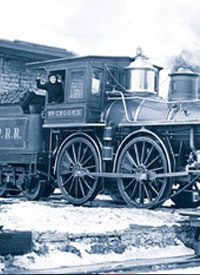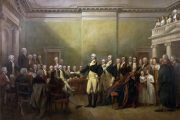
When Matthew Josephson wrote The Robber Barons in 1934, he tipped his hand as to his personal prejudice against the capitalists of the late 19th century:
Besides the young men who marched to [the Battle of] Bull Run, there were other young men of 1861 whose instinctive sense of history proved to be unerring. Loving not the paths of glory they slunk away quickly, bent upon business of their own. They were warlike enough and pitiless yet never risked their skin: they fought without military rules or codes of honor or any tactics or weapons familiar to men: they were the strange, new mercenary soldiers of economic life. The plunder and trophies of victory would go neither to the soldier nor the statesman, but to these other young men of ’61, who soon figured as “massive interests moving obscurely in the background” of wars. Hence these, rather than the military captains or tribunes, are the subject of this history.
His bias against the capitalists, who were busy building the greatest industrial nation the world had ever seen, ingratiated his work with statist historians who looked favorably on government intervention to “deliver us from these evils” and made Josephson’s attack required reading in high schools and colleges for decades thereafter.
The sobriquet “Robber Baron” has hence struck a pejorative chord in generations of graduates of schools that continue to teach that individuals such as Andrew Carnegie, John D. Rockefeller, and J.P. Morgan used the capitalist system to exploit the working class, form anti-competitive trusts, and obtain the accumulation of personal wealth above all else. Muckraker Ida Tarbell, author of the History of the Standard Oil Company, reinforced the idea that these soulless, industrialist Robber Barons were a destructive force and were willing to circumvent laws to accomplish their personal selfish ends.
Some historians disagreed with this portrayal. Josephson added a foreword to his book in 1962, complaining of the rise of “revisionist historians” who were disputing his interpretation of history:
Of late years, however, a group of academic historians have constituted themselves what may be called a revisionist school, which reacts against [my] critical spirit of the 1930’s…. To [these] revisionists of our history our old-time moneylords “were not robber barons but architects of material progress,” and, in some wise, “saviors” of our country. They have proposed rewriting parts of America’s history so that the image of the old-school capitalists should be retouched and restored, like rare pieces of antique furniture.
The development of the railroad industry in the 19th century provides a welcome opportunity to investigate such charges and determine if, in fact, such “revisionism” is justified and necessary.
The Birth of Railroads
During the Republic’s first 50 years, commerce was limited to the use of rivers, canals, and roads. Two events, however, changed the economic scene forever: the expansion of the “general commerce” clause under Article I, Section 8 of the Constitution by the Supreme Court in 1824, and the development of steam locomotives in England.
In Gibbons v. Ogden, Chief Justice John Marshall decided that the phrase “The Congress shall have Power … to regulate Commerce … among the several states” meant that the federal government was allowed to regulate commerce wherever it took place, including within the borders of a state. Prior to this decision, it was accepted that the federal government had power over only interstate commerce. This decision extended the definition of interstate commerce and cemented the power of the federal government over the states when state laws conflicted. It was greeted with great enthusiasm at the time, as it clarified and simplified matters greatly for those involved in such commerce among and between the states. This was going to have major implications after railroads became a reliable means of transportation because Justice Marshall’s decision in Gibbons was so vague that it allowed those favoring federal government intervention to involve the government intimately in the development of the railroad industry. At OriginalIntent.org, for instance, the author states:
There is little doubt that the commerce clause … was to be used for little more than insuring what we would call today, a “free trade zone.” That limited role is quite rightfully where the federal government’s authority in interstate commerce should end. Any reach for authority beyond that envisioned by the men who wrote the Constitution should be considered unconstitutional.
The first real exertion of substantial federal power under the interstate commerce clause came with the advent of the railroads in the mid-1800’s. The government assumed complete dominion over the early railroads, going so far as to grant regional railroad monopolies through Acts of Congress, as well as owning a large percentage of stock in various early railroad corporations.
The usefulness of railroads soon became apparent after their invention in England in the early 1800s. The South Carolina Canal and Rail Road Company first used steam locomotives in December 1833, followed by the Baltimore and Ohio Railroad (B&O) as the first common carrier, which initiated passenger train service using such locomotives soon thereafter.
Compared to roads, rivers, and canals, the advantages of rail transport were obvious: improved safety, year-round service, shorter delivery times, and lower costs. To budding entrepreneurs — the men of the “class of ’61” as referred to by Josephson — these advantages represented a once-in-a-lifetime opportunity.
The profit opportunities that railroads represented were apparent to politicians and non-politicians alike, but federal government involvement during this period was slowed by several factors, including the growing animosity between the agricultural southern states and the increasingly industrialized north. This animosity stemmed from the mercantilist efforts by northern states to institute high tariffs to “protect” growing industries from foreign competition, which negatively impacted southern states’ commerce abroad. Another reason was the resistance to the perceived abrogations of the Constitution by the North into southern states’ affairs, including the issue of abolition.
When federal legislation to build a transcontinental railroad was first introduced in 1845, it was successfully resisted by the southern states. However, the discovery of gold in California in January of 1848 set off such an explosion that it changed the question of federal government involvement in railroad construction from “whether” the federal government should get involved to “when, where, and how” such a railroad would be built. With the original strictures on the commerce clause largely removed, and the increasing marginalization of the southern states in their resistance to such unconstitutional incursions, it was just a matter of time before the government got involved.
Bills to initiate such construction were presented to Congress in 1860 and then again in 1861. When the southern states seceded from the union, thus removing their constitutional and economic challenges to such an effort, a bill was ratified and signed into law by President Abraham Lincoln in 1862.
Market-driven vs. Politically Driven
Although market-driven entrepreneurs had been busy building small railroads, railroad robber barrons weren’t yet a part of the American scene. But their time was at hand. Political entrepreneurs had been busy behind the scenes readying themselves for the coming explosion of opportunity to “game” the system.
Thomas DiLorenzo, in his book How Capitalism Saved America, points out the distinctions between the groups:
A pure market entrepreneur, or capitalist, succeeds financially by selling a newer, better, or less expensive product [or service] on the free market without any government subsidies, direct or indirect. The key to his success as a capitalist is his ability to please the consumer, for in a capitalist society the consumer ultimately calls the economic shots. By contrast, a political entrepreneur succeeds primarily by influencing government to subsidize his business or industry or to enact legislation or regulation that harms his competitors.
The first clear attempt by political entrepreneurs to “game” the system occurred immediately after passage of the Pacific Railway Act of 1862, when “The Big Four” were given control of the financing, construction, and operation of the Central Pacific Railroad. These were Leland Stanford, Collis Huntington, Charles Crock, and Mark Hopkins. Each of the Big Four invested $1,500 in their newly formed company, Central Pacific Railroad, and, using 30-year, six-percent U.S. Government Bonds, started building the railroad east from Sacramento. These bonds were issued at the rate of $16,000 per mile on the plains west of the Sierra Nevada Mountains, $32,000 per mile of track laid between the mountains, and $48,000 per mile of track laid over the mountains. In addition, the 1862 Act initially granted the railroads 10 square miles of public land for every mile laid, but that grant was increased to 20 square miles in 1864. By the time the Union Pacific Railroad met the Central Pacific Railroad in Promontory Point in Utah in 1869, the two companies had been given 242,000 square miles, a territory larger than Germany.
According to Norman Tutorow in his 1970 article in Southern California Quarterly, “Stanford’s Responses to Competition: Rhetoric Versus Reality,”
Leland Stanford and the men who ran the CPRR paid lip-service to the idea of free competition, but in practice sought to dominate competing railroad and shipping lines…. Stanford and his associates repeatedly entered into pooling arrangements to prevent competition, bought out competitors, or forced rivals to agree not to compete. Stanford and his partners viewed laissez-faire as applicable only to government controls, and not to … competition within the system.
One of the ways the Big Four milked the system was by setting up their own coal company to sell coal to their railroad. That company mined coal for two dollars a ton, but sold it to their railroad for six dollars a ton, and pocketed the difference. In other words, the Big Four essentially stole from the government that was financing the railroad — the railroad was just an intermediary involved in the theft.
The terminus of the Union Central Railroad, also authorized by the Act of 1862, was determined in a politically expedient decision by President Abraham Lincoln. In 1857, Thomas Durant, another political entrepreneur, hired Lincoln to represent his M&M Railroad in a lawsuit brought by some steamboat operators. When the Act of 1862 left the decision of the terminus in the hands of the President, Lincoln took the advice of his former client, and selected Omaha, Nebraska.
During this time, not all railroad magnates tried to “game” the system, however. James J. Hill built the Great Northern Railroad, he said, “without any government aid, even the right of way, through hundreds of miles of public lands, being paid for in cash.”
Hill got his start when he and several partners purchased a bankrupt Minnesota railroad that had been run by a well-known political entrepreneur, Jay Cooke. Cooke was no railroad man, but received the Northern Pacific Railroad as a payoff for his efforts in helping to finance the Union during the war. Because of the disincentives created by subsidies and land grants given on a per-mile basis, Cooke built his railroad shoddily and ran it poorly, and by 1873, the railroad was bankrupt. Biographer Michael Malone, author of James J. Hill, considered Cooke and his business associates to be “derelicts at best and thieves at worst.”
On the other hand, Hill learned the railroad business and built his line carefully and only as fast as could be justified by the growth of the markets he served. Not only was he scrupulous in managing costs, he well knew that his customers — farmers, miners, timber men, and others using his railroad — would succeed or fail along with him. His motto was: “We have got to prosper with you or we have got to be poor with you.” Accordingly, he encouraged his farmer-customers to engage in crop rotation and diversification. He provided free seed grain and even cattle to his customers, and stockpiled firewood and other fuel near his train depots for the convenience of his customers. He donated land that he purchased for his railroad to local towns for parks, schools, and churches. He even transported immigrants to help develop the land near his railroads, charging them only $10 if they promised to build farms nearby. He sponsored contests for the best wheat crop or cattle, and developed “model farms” to educate his customers on the latest technology and developments in agricultural science. Malone stated that Hill’s Great Northern Railroad was the “best constructed and most profitable of all the world’s major railroads,” even as the rates he charged fell steadily as he improved efficiencies in running it. Said Hill:
What we want is the best possible line, shortest distance, lowest grades and least curvature that we can build. We do not care enough about Rocky Mountain scenery to spend a large sum of money developing it…. A railroad is successful in the proportion that its affairs are vigilantly looked after.
The Panic of 1873 bankrupted most of the national railroads, but not Hill’s. In fact, his railroad was the only transcontinental railroad that never went bankrupt. Hill later stated that “the government should not furnish capital to these companies, in addition to their enormous land subsidies, to enable them to conduct their business in competition with enterprises [like mine] that have received no aid from the public treasury.”
As author Burton Folsom put it, Hill “had built the best railroad in America and had used it to beat subsidized rivals time and again. He helped open the Northwest to settlement…. He made a difference in the way the world worked…. He was the real hero in the drama of the American transcontinental railroads.”
Folsom concluded his study with these words:
If we seriously study entrepreneurs, the state, and the rise of big business in the United States we will have to sacrifice the textbook morality play of “greedy businessmen” fleecing the public until they at last are stopped by the actions of the state.
Current negotiations taking place in Washington over “financial regulation” provide a perfect example of political entrepreneurs successfully gaming the system. There are more than 2,000 lobbyists pressuring politicians to create a bill that won’t impact banks and other financial institutions very severely. Matt Taibbi, writing in Rolling Stone magazine, disclosed that politicians and lobbyists “tinkered with amendments on all four fronts of the war [against Wall Street] just enough to keep many of them from having any real teeth.” He quotes one Democratic aide: “They’re working [together] to come up with a bill that Wall Street can live with.”
Josephson’s complaints that his history was being unfairly rewritten by authors such as DiLorenzo, Malone, and Folsom are simply not justified when accurate and complete history is brought to light. Remember that political entrepreneurs become wealthy at the taxpayers’ expense and use the power of government to protect that wealth, while free-market entrepreneurs become wealthy only when they successfully meet their customers’ demands.



